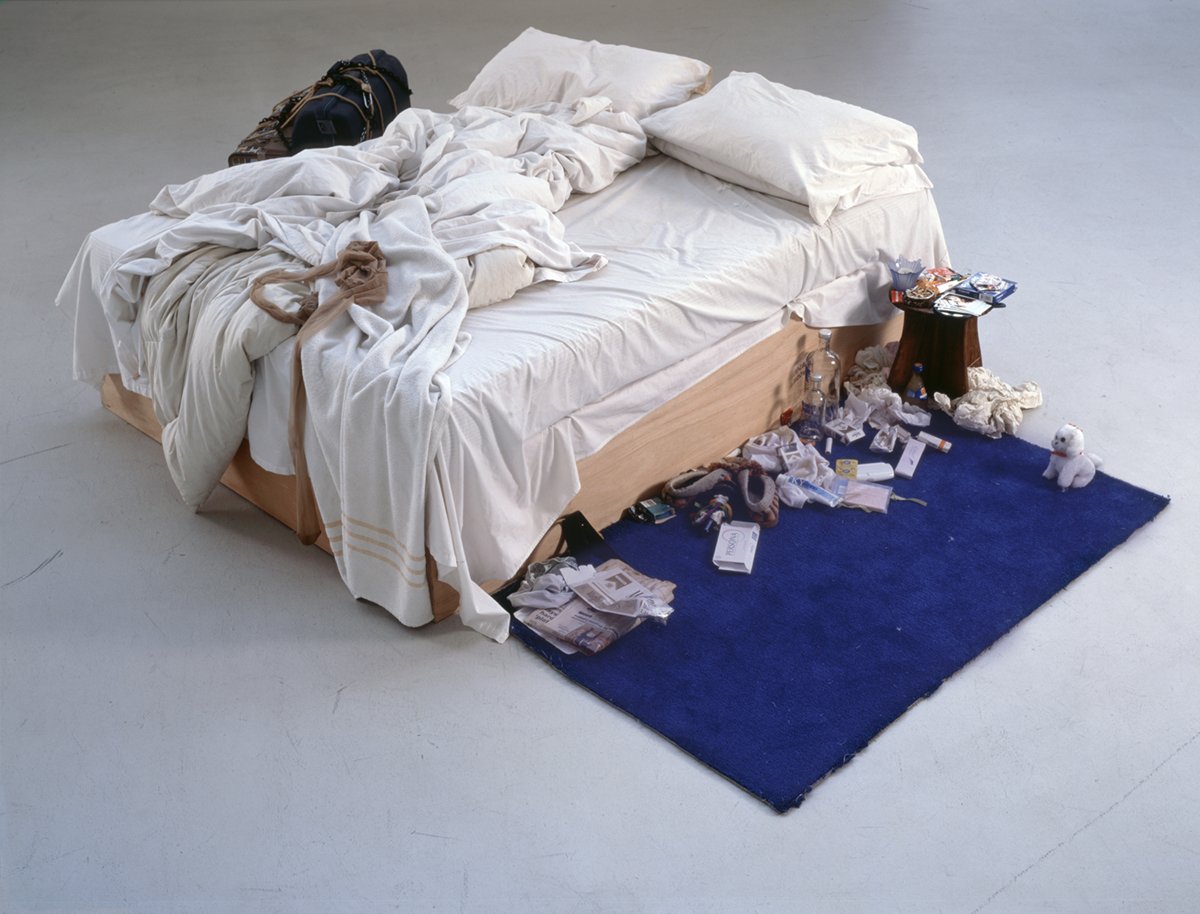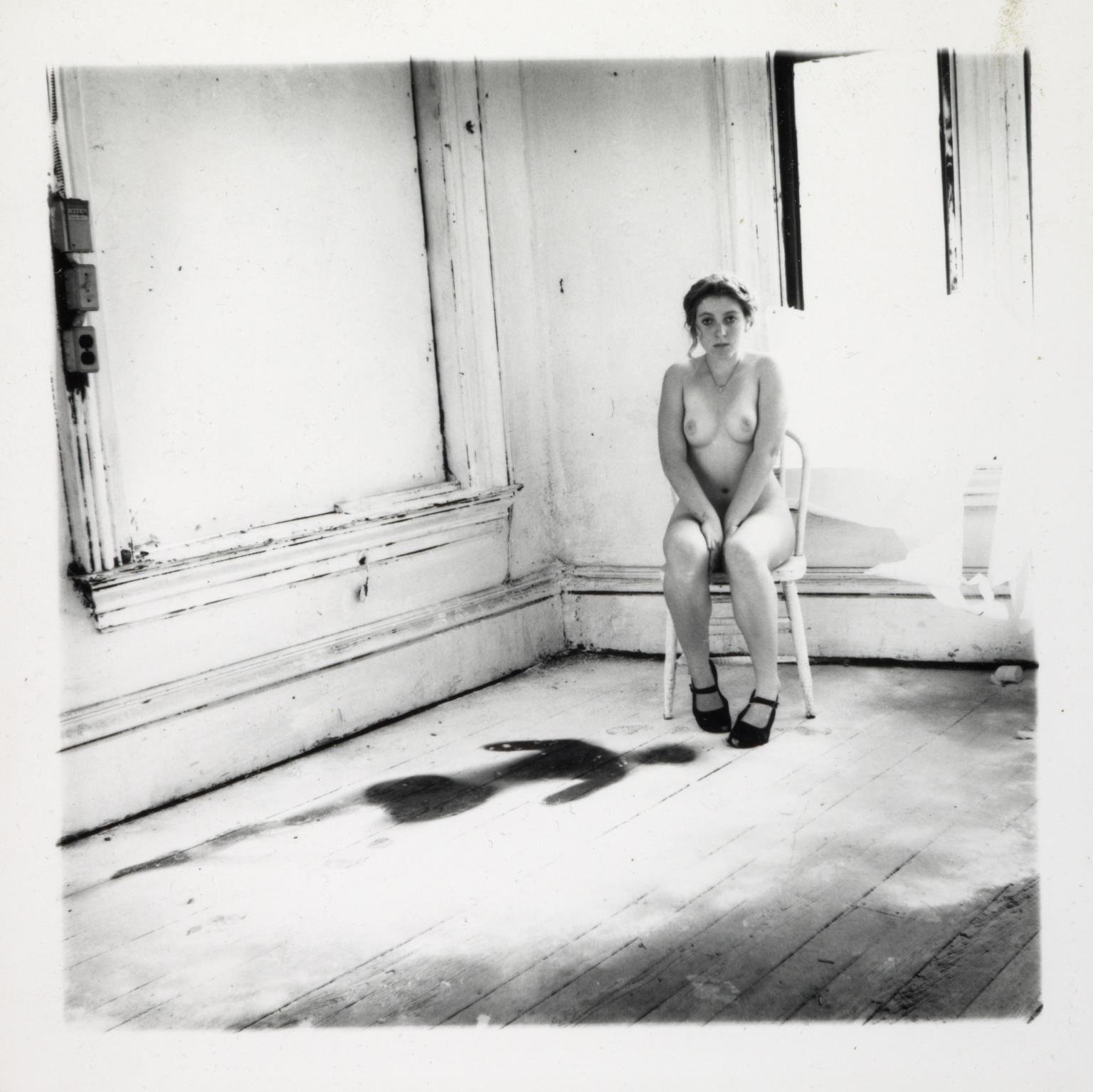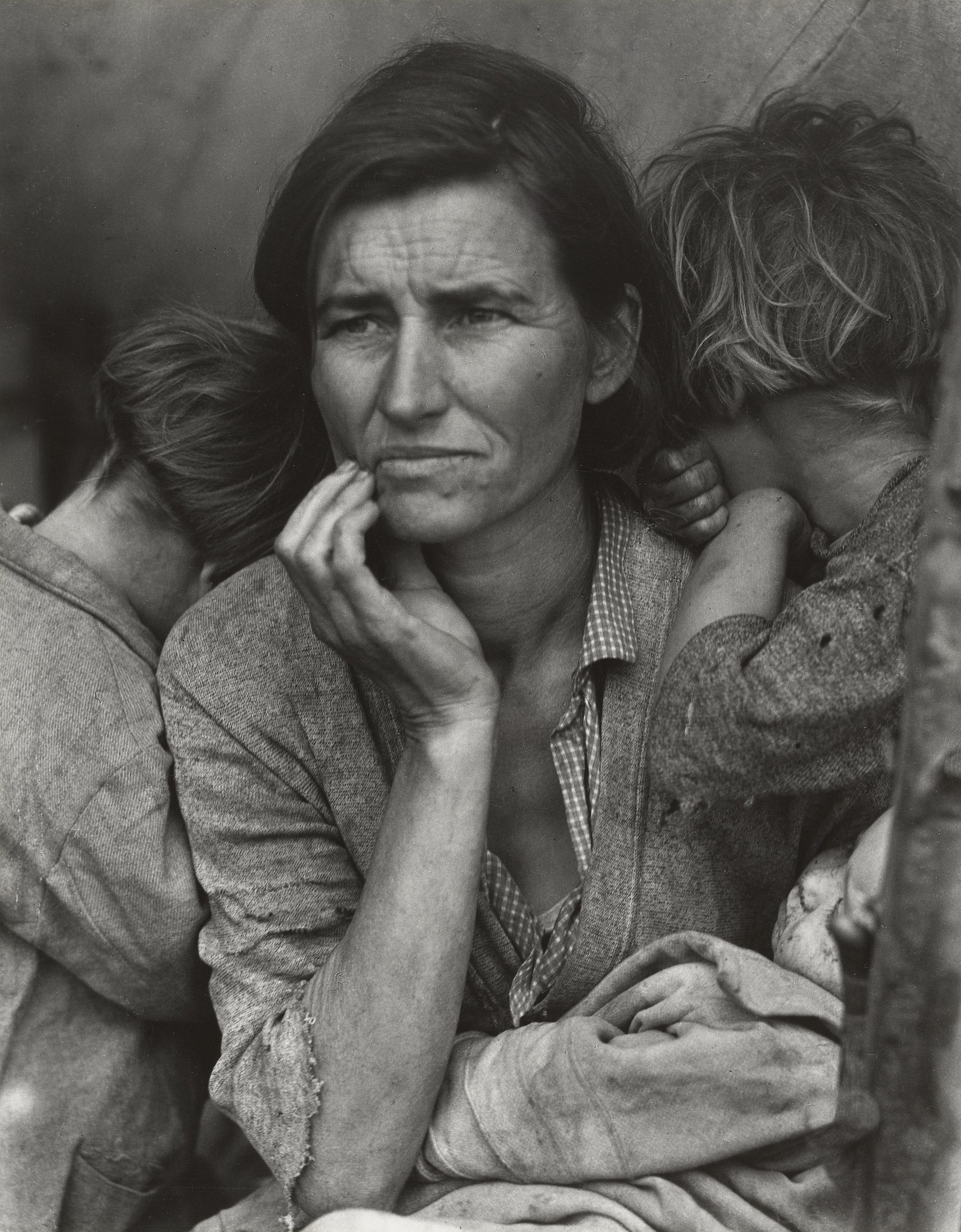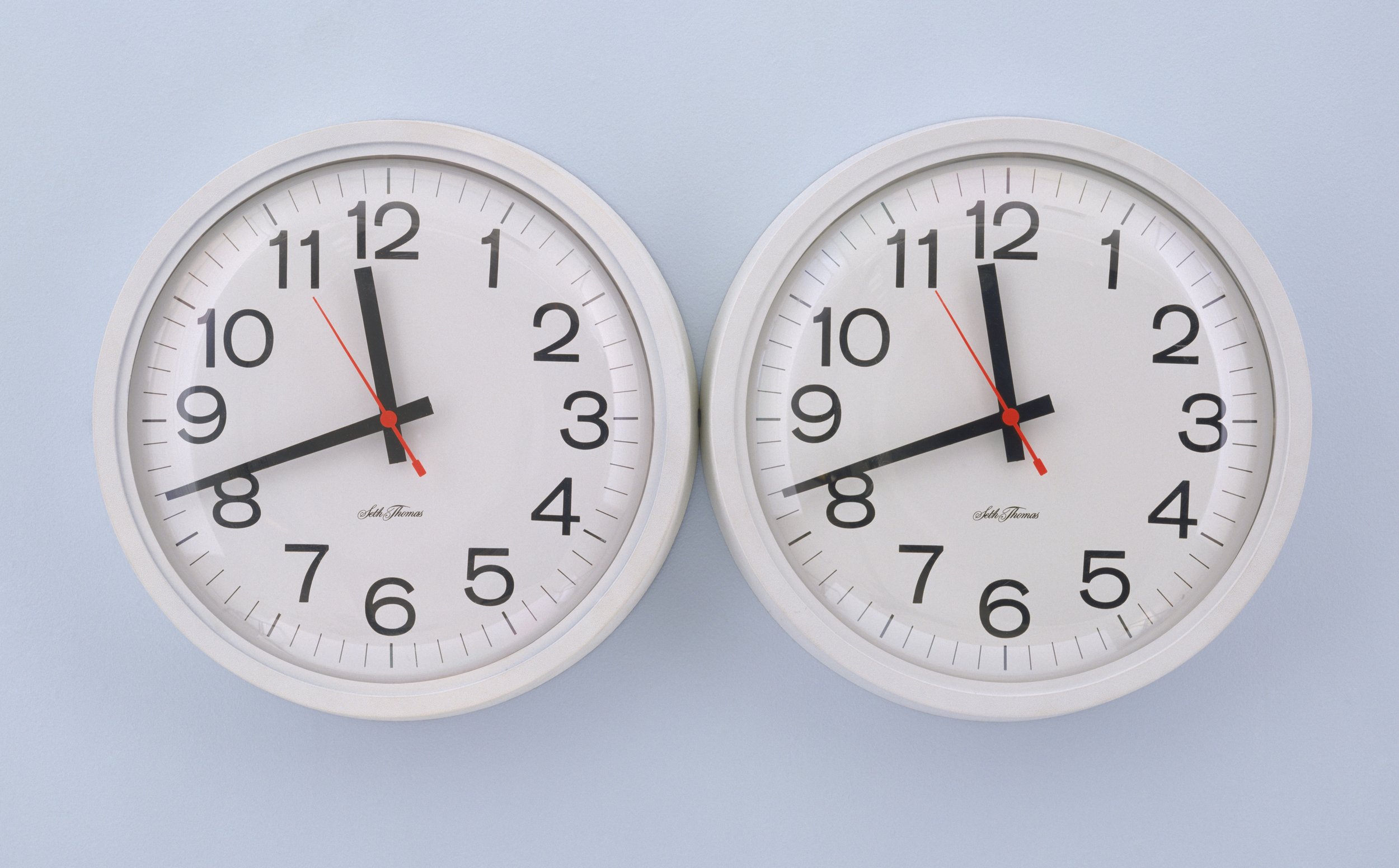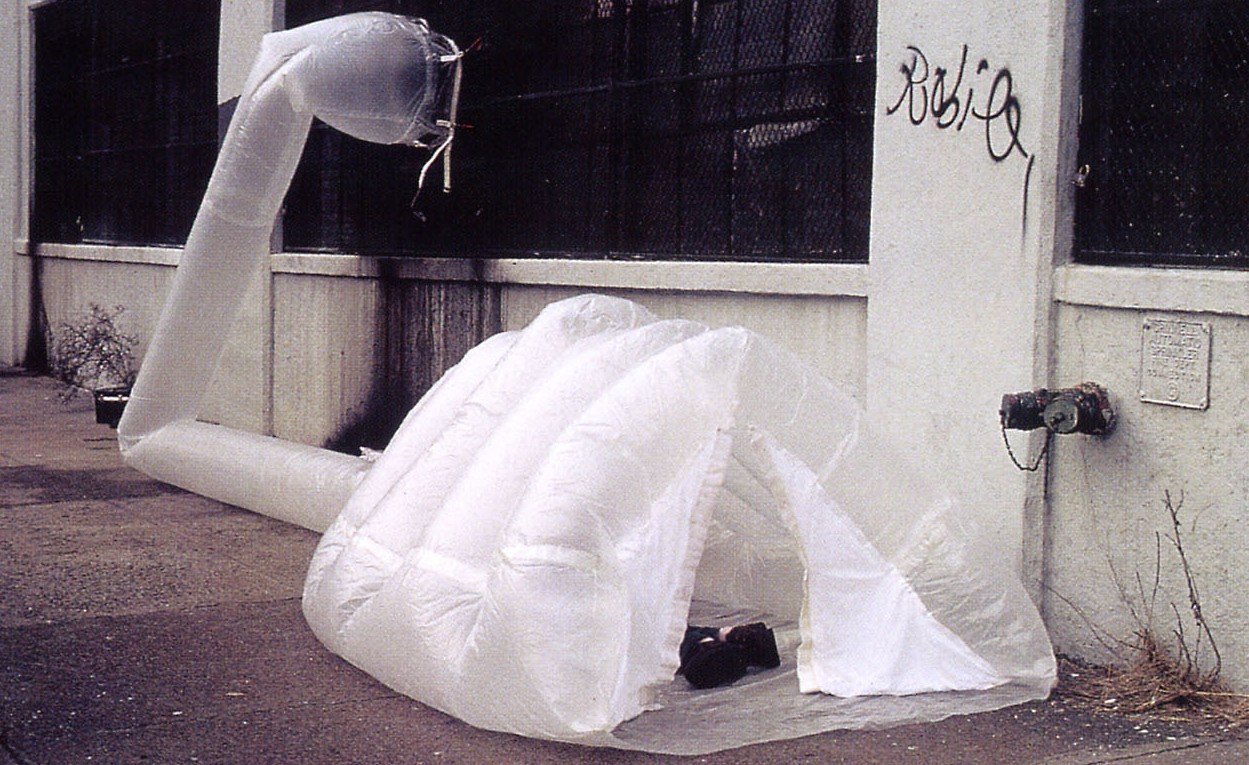Part 1 - Overview
1.1. Introduction to Art & Society
Explore works of art created in response to the social, cultural, and political issues of their time. Gain a deeper understanding of history and contemporary society. Be encouraged to think critically about world events and how they are depicted.
Many artists create work in response to the social, cultural, and political issues of their time. This theme offers a deeper understanding of history and contemporary society, and encourages you to think critically about world events and how they are depicted. The introduction video is the place to begin. It focuses on three works of art—an iconic Depression-era photograph by Dorothea Lange; Martha Rosler’s photomontage protest against the Vietnam War; and Felix Gonzalez-Torres’s expression of love and loss through two wall clocks—through which you will explore this theme. The slideshow expands upon these artworks and features many more, ranging from Michael Rakowitz’s parasitical and custom-designed homeless shelters to Kerry James Marshall’s quiet painting of a black police officer that encapsulates the complexities of race and policing in 21st-century America.
Learning Objectives
Analyze works of art created in response to the social, cultural, and political issues of their time.
Examine how world events are depicted in works of art.
Evaluate the role of art in developing engaged citizens.
Part 3 - Read & Review
3.3. Art & Society Discussion Prompt
Can art make us better, more engaged citizens? If so, in what ways? If not, why? Support your opinion by referencing or posting an image of an artwork, either one you’ve found or one you’ve created. Then, respond to another learner’s post that resonates with or interests you.
Art can make us better, more engaged citizens. Specifically, art can raise awareness about issues citizens might not have known about otherwise. Art can prompt citizens to learn more about specific issues. Art can also provide a vehicle for citizens to have conversations about challenging issues. And, art can inspire citizens to take up action on specific issues.
In the 2018 exhibition VORTEX, Canadian artist Douglas Coupland created a sculpture and several large installations at the Vancouver Aquarium using plastic waste Coupland found and collected along the coastline of British Columbia. Coupland’s goal behind displaying these artworks was to create awareness and discussion about the large volume of plastic waste that regularly ends up on our shores.
In 2010, I made a series of photographs to illustrate the large amount of waste generated by consumers who fail to properly dispose of their single use, hot coffee cups. I made the photos look like advertisements by the coffee chain TIM HORTONS as a way of cultivating awareness and discussion about the issue. EVERY CUP TELLS A STORY had been a campaign designed to allow customers to share heartwarming stories about how Tims coffee had brought them together with friends and family. Here, the slogan also serves as a reminder of how every cup also has a story of waste attached to it.
After you’ve gone through this process, describe how would you introduce this theme to your students. What question could you ask or what activity could you develop to give them an entry point into the theme?
I’d ask students to brainstorm issues and causes that are important to them. I’d then have them share what they came up with and I’d record them on a large whiteboard so everyone could see the results. If different students came up with similar ideas that fit a common overall idea, they’d get grouped together (for example one student might be interested in plastic waste, and another might be concerned about deforestation - so both of those fit into the larger issue of environmental protection). Ideally there would be several common themes that emerge where students could be broken into a few small groups and asked to collaborate together on the creation of a mixed media collage about their issue.
3.5. Weekly Reflection
Reflect on what you learned this week. What did you learn that was new or surprising?
It was fascinating to learn how imagery can be molded during the process of creation to best represent the ideas an artist wishes to convey. For example, Dorothea Lange made five exposures before capturing the one that would be known as MIGRANT MOTHER. With each shot, Lange was closer and tighter to her subject, and had chosen specific elements to either include or exclude.
Did any of the artworks resonate with you?
Martha Rosler’s use of contrasting found imagery in her HOUSE BEAUTIFUL (BRINGING THE WAR HOME) series helped to highlight the stark differences between the harsh realities of the Vietnam war and the notions of the American dream being sold in glossy magazine stories and advertisements. I also appreciate the grassroots level this project began at, as leaflets distributed to every day people.
Did your perspective on any of the artworks change by looking at them through this week’s theme?
As I learned more about the story behind MIGRANT MOTHER, I learned how myths about certain characters and events can be created. This isn’t necessarily a bad thing, rather it highlights how a narrative can be constructed to serve a certain ends, in this case, about how this woman was made to possibly look less privileged than she was. For example, she was not a part of the nearby farming community, and had been waiting for her husband and son to return with parts to fix their vehicle so they could move on in their search for work.
Part 4 - Lesson Choices
Learning Objectives
Analyze works of art created in non response to the social, cultural, and political issues of their time.
Examine how world events are depicted in works of art.
Evaluate the role of art in developing engaged citizens.
4.1. Written Reflection
Think about the themes we explored in this course: Places & Spaces, Art & Identity, Transforming Everyday Objects, and Art & Society. Find a work of modern or contemporary art (made after 1880) in a museum collection. In 150-300 words, describe the work and connect it to one of the themes. You can either explain how it reflects at least two of the key ideas explored in that theme or compare it with two artworks explored in that week of the course. Indicate the artwork title, artist(s), date, and medium by including this information with your submission or linking to the page about the artwork on a museum’s website.
Questions to consider when writing (optional):
Why did you select this artwork?
How does this artwork resonate with something in your own life?
Does this artwork connect to other themes within the course and if so, how?
Tips: You can select an image from MoMA’s website or another museum website. Refer to each week’s learning objectives to review some of the key ideas explored.
Note: If you have submitted the final assignment but it is marked as incomplete, you may still need to peer review others' responses, and have your submission reviewed. This process can last a few days, so your work may not be marked as complete immediately. Read more about peer review assignments.
Two artists, two times: two beds
Artist Tracey Emin’s 1998 installation, MY BED, is a work which fits the ideas explored under the unit, TRANSFORMING EVERYDAY OBJECTS. Specifically, the art work is composed of a box frame and mattress, with linens, pillows and various objects which. In this case, Emin’s MY BED is similar to Robert Rauschenberg’s 1955 work, BED, in that they both contained objects that belonged to the artist’s. The unit describes how:
“(Rauschenberg) called it Bed because it was his quilt and pillow. It was called art because it was on the wall. (Rauschenberg explained how): ‘Painting relates to both art and life. I try to act in the gap between the two.’ Critics didn't know what to call it. Was it a painting? Was it a sculpture? Rauschenberg ended up calling it a combine.”
Further, the unit discussed how:
“Many artists use everyday objects—like beds, bicycle wheels, and teacups—to challenge assumptions about what constitutes art and how it should be made.”
Beginning with work by Duchamp, “Readymade's challenged every definition of art ever.” Neither Rauschenberg’s work nor Emin’s work was either handmade by the artist, nor was it considered beautiful. But both bring otherwise banal everyday objects into the gallery space in order to give them new meaning.
In terms of transforming objects, the unit notes how: “The idea that if you alter an object, it alters your perception of what that object is.” The unit also teaches how: “Rauschenberg blurs the line between an object that exists in the world and an object that exists as a work of art.” And while Rauschenberg has physically altered his found objects through the formal medium of painting, Emin’s work stands out for not so much how she has altered the objects, but in how she has placed the objects in front of gallery viewers as a physical segment of her life at a specific point in time.
Finally, I chose to look at MY BED because of the personal connection Emin had with everything in the piece, without judgment, all of which had been used by the artist during a time when Emin had suffered from a depression brought about by a traumatic breakup. In many ways, Emin’s installation works like an autobiographical snapshot of that specific moment in time from her life, containing all of the elements that existed in the moment she came out of her depression. Having suffered from my own mental health issues I can relate to how a bed can represent a place of escape, refuge, and safety for someone who is suffering. But in this case, Emin’s work differed from Rauschenberg’s, in that Emin’s tackles the emotional issues associated with the objects, whereas Rauschenberg’s work tried to avoid such questions. Rauschenberg’s work was a reaction against the “…brooding, personal” pieces of abstract expressionism, which Rauschenberg felt required “…time to feel sorry for yourself if your going to be a good abstract expressionist.” Emin’s work was itself created in a more post-modern moment where elements of the personal could again be portrayed.
Tracey Emin. “My Bed.” 1998. Box frame, mattress, linens, pillows and various objects. Overall display dimensions variable.
Robert Rauschenberg. “Bed.” 1955. Oil and pencil on pillow, quilt, and sheet on wood supports, 75 1/4 x 31 1/2 x 8" (191.1 x 80 x 20.3 cm)
Peer Reviewed Feedback
4.2. Curate a Set of Images
Think about the themes we explored in this course: Places & Spaces, Art & Identity, Transforming Everyday Objects, and Art & Society. Select 5-10 images that you feel respond to or critique one of these themes. The images don’t need to be in a museum collection; they can be photographs from a magazine or the newspaper, for instance, or images you made. If you wish, you can collage the images or otherwise combine them to create a visual representation of your chosen theme, but it is also fine to simply share them as a list of images or links. Write a short paragraph (up to 150 words) that communicates which theme you responded to, why you selected the images and, if applicable, how you combined or arranged them.
ART & SOCIETY: I shot this photo series on October 22, 2021 to feature dozens of little signs cut into the shape of orange t-shirts which sprinkled the gardens of the Catholic STAR OF THE SEA PARISH in the city of White Rock, in British Columbia, Canada. Many of these tiny handmade signs had the number “215” marked on them in black ink, representing the number of remains of Indigenous children that had been found on the site of one former Residential School near the city of Kamloops, also in British Columbia. This display was one of the many acts of remembrance that have taken place this year in light of over a thousand remains being found at the sites of former schools across Canada. In the 2015 Truth and Reconciliation Report, Canada’s residential schools were described as “…a systemic government sponsored attempt to destroy Aboriginal cultures and languages and to assimilate Aboriginal peoples so that they no longer existed as distinct peoples.”
Peer Reviewed Feedback
Teaching with Themes
Part 3 - Peer Reviewed Assignment
February 21, 2023
Part One: Select Your Theme
Select a theme. You can choose a theme from the course or from MoMA Learning, or create your own. Remember that a good theme is a universal concept that can be explored on its own and is relevant to students’ lives. For example, Dada is an art movement, but Artistic Collaboration, which relates to Dada, could work as your theme.
Test it through the Theme Machine. If your theme was not successful, choose another theme to test.
When you identify a theme that is successful in the Theme Machine, describe your theme in one sentence.
Topic: Depression, anxiety, and loneliness
Theme Statement: A central theme explored in the fine art photographs by artists Francesca Woodman, Eva Charkiewicz, Jackie Dives, and Janelia Mould is that major depressive disorder can destroy a person’s ability to concentrate, enjoy life, feel connected with others and good about themselves, sleep, and work.
Part Two: Select Your Artworks
Choose 2-4 works of art that have not been discussed in this course to explore in your theme. We encourage you to select works of art from a local museum or gallery. You can also select images from MoMA’s website or another museum website. For each work, indicate the title, artist(s), date, and medium by including this information with your submission or linking to the page about the work on a museum’s website.
Write 100-200 words about how the works of art connect to your theme.
Francesca Woodman. “Untitled, Providence, Rhode Island.” Black & White Film Photograph. 1976.
Francesca Woodman’s work explores many themes related to anxiety, identity, depression, and loneliness, often through a surrealist black and white lens which helps to give her film photographs a timeless quality (surrealist art is marked by the intense unbelievable, fantastical, and irrational reality of a dream. Specifically, the Tate notes how: “It balances a rational vision of life with one that asserts the power of the unconscious and dreams. The movement's artists find magic and strange beauty in the unexpected and the uncanny, the disregarded and the unconventional”).
In “Untitled, Providence, Rhode Island, 1976,” Woodman presents herself as a solitary figure in a sparse, forgotten and desperate space. The camera is also placed further back from Woodman, so there’s space between her and her viewers, as if the viewer is watching from afar, afraid to approach the subject. The light from the window behind her is so blown out that it’s impossible to place the space in any specific location, urban or rural. Anyone observing this scene could imagine it in their own town.
Wearing only shoes and a necklace, Woodman is sitting nude on an old chair, and nothing here hides the emotional state she is in. Her face is forlorn and despondent, she looks very much lost and alone in her solitude. The shadowy silhouette of a figure on the floor feels ghostly, as if it were representative of something that used to exist, perhaps before the depression set in.
Finally, it is important to note that this reading simply comes from a reading of the photograph itself. Biographical evidence of Woodman’s life notes that she appeared to be happy during her time studying at the Rhode Island School of Design. Later, after graduating from her program, Woodman would develop depression as she struggled to get her work shown, and she did ultimately take her own life. There are some who have tried to argue that this work foreshadowed and illustrated her personal struggles with depression, but there are also those who argue that this was not the case. Olga Hubard cautioned people to be mindful of the impulse to psychoanalyze the artist, and that seems particularly important to remember when studying the work of Woodman. An artist can create imagery that explores ideas about anxiety, depression, and mental illness without the artist having to have also suffered from those maladies.
Jackie Dives. “Untitled.” Colour Film Photograph. ~1990s.
As a teenager, artist and documentary photographer Jackie Dives shot a lot of photographs on film but didn’t end up developing a lot of those rolls until after a few decades had passed. It took a lot of strength for her to develop the rolls as she knew they were taken during a period in her life when she lived with anxiety and depression. But she also considered them as representing a major gap in her artistic development, one that she was curious about. About her struggles, Dives says: “So much of my experience has been pretending not to be depressed, instead of figuring out how to live with it” (Berman).
Formally, this image is an untitled colour photographic self-portrait shot on film and the content it contains also informs the ideas about a teenager hiding her struggles with anxiety and depression. This untitled 1990s image was digitally scanned from its film’s negative for inclusion in the Georgia Straight article. It was also printed for display at a one night only, four-hour long exhibition held on March 30, 2017, in Vancouver, British Columbia, Canada. The size of the print is like the size of photo one would get from a one-hour photo lab, ~5”x7.
Overall, this photo has an off-white monochromatic colour palette that serves to informs its overall tone. It helps to secure the image in a kind of dreamlike state – a moment captured in time and held there for viewers to see. David Kastan and Stephen Farthing, speaking in their book ON COLOUR, described how monochromatic black and white, as well as sepia images, can exist simply as the colour of memories (201). Specifically, Kastan and Farthing explain how monochromatic greys can become a representation of, “Not of what we remember but the color of memory itself, which is always, at least in part, a kind of amnesia” (201). They further note how the greyness of black and white monochromatic photographs “…works to sequester their images securely in the past.” Here, Dives is wearing a simple, plain sweater that is either light tan, or even white in colour. The background of this photo is also very sparse, and contextually, this self-portrait of Dives is very minimalistic [an art movement that began in the 1960s as a rebellion against abstract expressionism and modernism. Minimalist art (whether it was in music, literature, or the visual arts), was characterized by extreme spareness and simplicity] in its feel than some of her other self-portraits. Ultimately, it’s safe to suggest that both the monochromatic tone and minimalist feel of this photograph lends to the emptiness one can feel when lost in the haze of despair.
Shot with a snapshot aesthetic, this photo also has a slight vignetting, which Adobe describes as: “…a darker border - sometimes as a blur or a shadow - at the periphery of photos. It can be an intentional effect to highlight certain aspects of the image or as a result of using the wrong settings, equipment or lens when taking a photo.” The vignette here enhances the overall ghostly feel to the image, and it removes it from being grounded in any one specific place and lends to the idea that the subject of the photo, whose facial expression conveys the emotion of someone barely surviving, exists in a kind of fog, both existentially and physically.
Unlike the work of Woodman, we can connect the ideas associated with anxiety and depression to the feelings Dives’s experienced as a teenager because Dives talks about this context in relation to the photographs she took during this time in her life. Dives has also discussed how she views photography as a kind of therapy and way of working through and exploring her experiences.
NOTE: This section on Dives primarily used work from a much larger piece I wrote in fall 2022 for a course at Kwantlen Polytechnic University, IDEA 2900, which can be found here.
Janelia Mould. “{ADORNMENT}.” Colour Photograph. 2018.
Janelia Mould is a fine art photographer who also explores the depression that impacted her life through her photographs. Like Woodman, Mould’s works are surreal and dreamlike, and often only show parts of her body. Speaking with My Modern Met, Mould notes: “I have purposefully left out the head and some limbs… I wanted to give a glimpse on how a person with depression might experience life, through creating a character that never feels fully complete” (Stewart).
Like Dives and Charkiewicz, Mould shoots her portraits in colour, but here her 2018 photo is grainy, and not tack sharp, mimicking the feel of an older roll of colour film, possibly shot in low light with a high ISO. It gives the portrait a hazy feel, as though the figure exists out of time, lost in the fog of despair. Here, it’s suggested that the unknown figure is also nude like Woodman, leaving the figure vulnerable to a viewer’s gaze.
On her belly is something that appears to be a tattoo, only here it’s an embroidery the figure is applying to herself in an almost nonchalant manner. There’s no blood, no suggestion that she is in pain as she threads the needle with red thread. This is telling as the pain associated with depression is also usually hidden below the surface of those who are suffering. It’s also interesting to see the figure do this to herself as some psychologists have linked the getting of tattoos to be representative of a person’s struggles with mental illness. One study conducted in July 2016 of 2,008 adults living in the United States found that “…people with tattoos were more likely to be diagnosed with mental health issues and to report sleep problems” (Wood). But by changing the tattoo to an embroidery, Mould is making a link to a tradition that is strongly feminine in its craft. It may also be leaning into the long held notion that more women suffer from depression than men, although there are psychologists who believe the difference lays in the possibility that women are more likely to report having depression than men.
Finally, Mould has called this piece “{ADORNMENT},” which refers to an embellishment or colourful decoration. A decorative distraction to keep people’s focus on something superficial. With each of Mould’s photos in this series, she quotes an author, in this case, Rachel Wolchin:
"I assure you, l'm not put together at all.
Nor am I broken.
I'm recovering -
finding the beautiful in the ugly and stitching it into my life."
The quote emphasizes a desire to overcome the depression, but it leaves one wondering if the approach is in any way sufficiently sustainable.
Eva Charkiewicz. “Everything Passes Away.” Colour Photograph. 2021.
Eva Charkiewicz is another fine art photographer who explores the depression she’s experienced through the self portraits she’s produced. Like Dives, Charkiewicz sees her creative process as being therapeutic, noting how: “I want to show you my world (my four walls) – my photographs. I became interested in photography after being diagnosed with clinical depression. Photography helped me and still helps me with my emotions” (The Perspective Point).
Her 2021 photo, Everything passes away… is deceptively simple in its construction, and similar to the Dives photo above in its monochromatic use of colour. There’s an overall bluish grey tonal haze punctuated by her muted orange-red sweater. The red is reminiscent of a kind of life blood that’s being drained from the figure. And the blue grey haze feels like a wash of colour that’s been painted onto the image, one that also has a slight grainy effect that is evocative of the grain found in Mould’s photograph.
There are two figures visible, and the bodies of both figures face forward but there heads are turned towards each other, looking away from the viewer. All of these elements succinctly captures the isolating feeling that depression can have, leaving people turning inward, unaware of the world around them. That the figure on the right is more opaque than the one on the left suggests something about the individual is being lost due to the depression. It’s not that dissimilar to the impression of a figure on the floor of Woodman’s image.
Part Three: Summary (100-200 words)
What interested you about the theme you chose?
Why did you select these artworks?
Which age group or grade level did you have in mind when selecting this theme?
How would you introduce this theme to your students? What question could you ask or what activity could you develop to give them an entry point into the theme?
Ultimately, I was interested in the theme of depression as I’ve personally suffered from major depressive disorder for most of my life. And for better or for worse, it’s a theme I’ve also explored in my own fine art photography and non-fiction writing.
Seeing how other artists examine this malady through their own work also interests me, irregardless of whether or not they have personally suffered (to this end, I am reminded how Olga Hubard cautioned people to be mindful of the impulse to psychoanalyze the artist and their process, which is why I started with an examination of work by Francesca Woodman).
In terms of an age range for presenting this work to, I believe the work could be shown and discussed with those who are aged 13 and older. The work shown here by Woodman and Dives was done while they were teenagers, and the issues of depression, anxiety, and loneliness impacts many teenagers. It’s also known that making art can serve as a kind of therapy for working through difficult feelings and struggles.
To that end, I’d introduce the theme of depression by having students share moments when they’ve felt sad or depressed, or moments when they’ve seen family or friends feel that way. We’d then discuss how art could provide a way for expressing those feelings. Finally, I’d have students create an artwork that expresses the emotions they’ve felt or seen others feel, as discussed earlier in the session. Students could use whatever medium of expression they felt drawn to: collage, drawing, painting, photography, or even writing a poem or short story - fiction or memoir.
Works Cited…
Berman, Sarah. “Faded Snapshots from Teen Years Spent Lost and Depressed.” Vice, 19 Feb 2017.
The Perspective Point. “Eight artworks inspired by mental health problems.” The Guardian, 17 Jan 2018.
Stewart, Jessica. “Interview: Photographer Explores Own Depression with Surreal Self-Portraits.” My Modern Met, 10 Mar 2017.
Tate. “ART TERM - SURREALISM.”
Wood, Janice. “People With Tattoos More Likely to Also Have Mental Health Issues.” PsychCentral, 27 Jan 2019.
Peer Reviewed Feedback
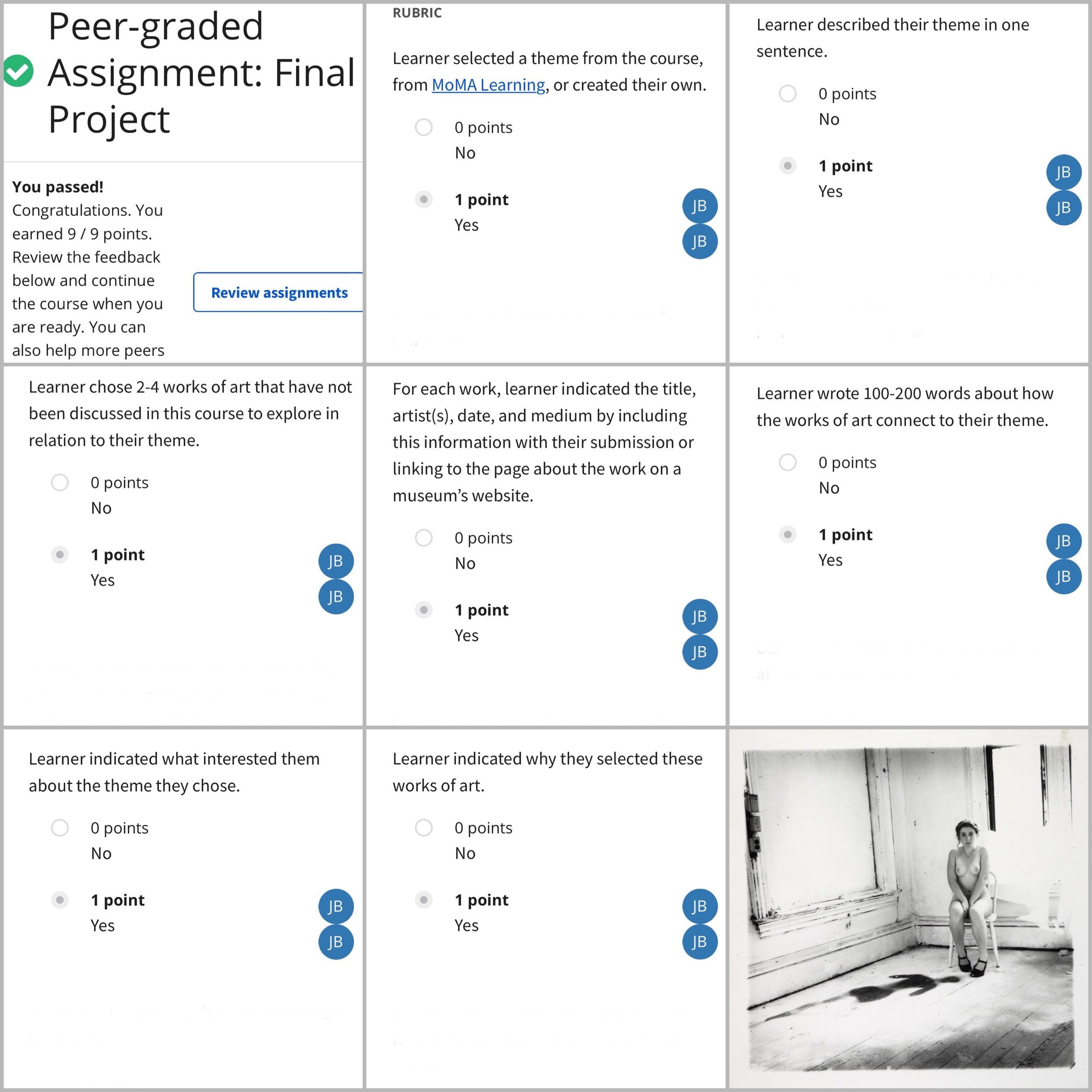
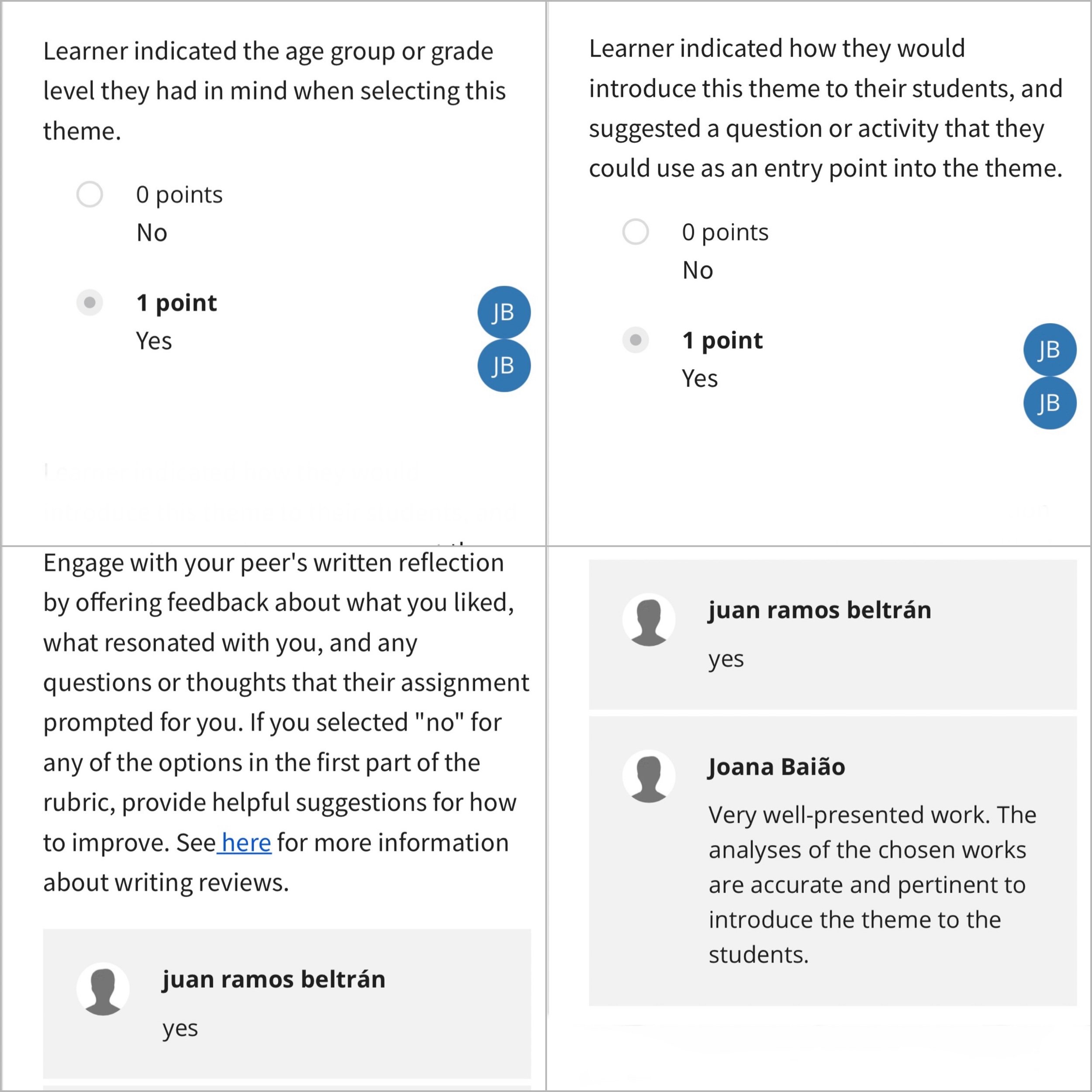
Unit Review
Teaching with the theme of Art & Society allows one to:
Use a variety of primary sources;
Address complex issues in an accessible way; and
Make connections between historical and current events.
Teachers can help students build deeper relationships with works of art by facilitating a discussion of personal meaning within a larger sociocultural context.
Olga Hubard believes that the viewer’s experience comes first and information should be provided only if it does not disrupt the free flow of ideas.
Examples of productive and/or useful information, according to Hubard include:
Student interpretations; and
Cultural context and meaning;
Descriptions of artworks.
Olga Hubard equates gathering information to a fully stocked pantry from which you select only what you need for a specific recipe.
Olga Hubard cautions us to be mindful of the impulse to psychoanalyze the artist and his process.
Migration Series is based on research Jacob Lawrence conducted at the 135th Street Library in Harlem.
To make Migration Series, Jacob Lawrence use a consistent set of paint colours to make the 60 panels, feel like a unit, like one work.
The following is true about Dorothea Lange’s Migrant Mother:
It was taken during the great depression in America; and
The closeness of Lange’s framing helps to give the image its power.
Martha Rosler combined the following to create the series, House Beautiful:
Images of the conflict in Vietnam; and
Advertisements from magazines that were popular at the time.
Felix Gonzales-Torres’s Untitled (Perfect Lovers) was created in a time where the HIV/AIDS epidemic was greatly affecting American society.
Through the imagery in Candied, Shahzia Sikander implies a story but does not provide a specific narrative.
Michael Rakowitz’s paraSITE homeless shelters are affordable, but not because they are mass produced.
Together with the occupant, Michael Rakowitz develops custom made plans for his paraSITE homeless shelters, builds them, and distributes them to the occupant.
Ernst Ludwig Kirchner responded to or represented the following in Street, Dresden:
The industrial, technological, and intellectual innovations of modernity;
The frenetic piece of contemporary life; and
The feelings of isolation and loneliness that can exist even when in the midst of a crowd of people.
Kerry James Marshall’s central figure in Untitled (policeman) complicates the issue of police shootings in America by how:
He stands as a reminder that many Black people serve in the police force; and
He is black.
Carolyn Lancher argues that Jasper John’s Flag collapses the difference between reality and illusion.
Steven Pinker argues that because we are primates and thereby largely visual beings, translating complex relationships – including the various costs of over-imprisonment illustrated in the Million Dollar Blocks project - individual formats helps us to understand them.
Jacob Lawrence. Migration Series. 1940–41. Casein tempera on hardboard, 60 panels, dimensions vary.
Dorothea Lange. Migrant Mother, Nipomo, California. 1936. Gelatin silver print, 11 1/8 x 8 9/16" (28.3 x 21.8 cm).
Martha Rosler. Cleaning the Drapes from the series House Beautiful: Bringing the War Home. c. 1967–72. Pigmented inkjet print (photomontage), printed 2011, 17 5/16 x 23 3/4" (44 x 60.3 cm).
Felix Gonzalez-Torres. "Untitled" (Perfect Lovers). 1991. Clocks, paint on wall, overall 14 x 28 x 2 3/4" (35.6 x 71.2 x 7 cm).
Shahzia Sikander. Candied. 2003. Ink, colored ink, and gouache on twenty pieces of prepared paper, Each: 15 x 11" (38.1 x 27.9 cm).
Michael Rakowitz. paraSITE homeless shelter. 1997. Polyethylene, 42" x 36" x 11' (107 x 91.5 x 335 cm).
Ernst Ludwig Kirchner. Street, Dresden. 1908 (reworked 1919; dated on painting 1907). Oil on canvas, 59 1/4" x 6' 6 7/8" (150.5 x 200.4 cm).
Kerry James Marshall. Untitled (policeman). 2015. Synthetic polymer paint on PVC panel with plexi frame, 60 x 60" (152.4 × 152.4 cm).
Jasper Johns. Flag. 1955. Encaustic, oil, and collage on fabric mounted on plywood, three panels, 42 1/4 x 60 5/8" (107.3 x 153.8 cm).

